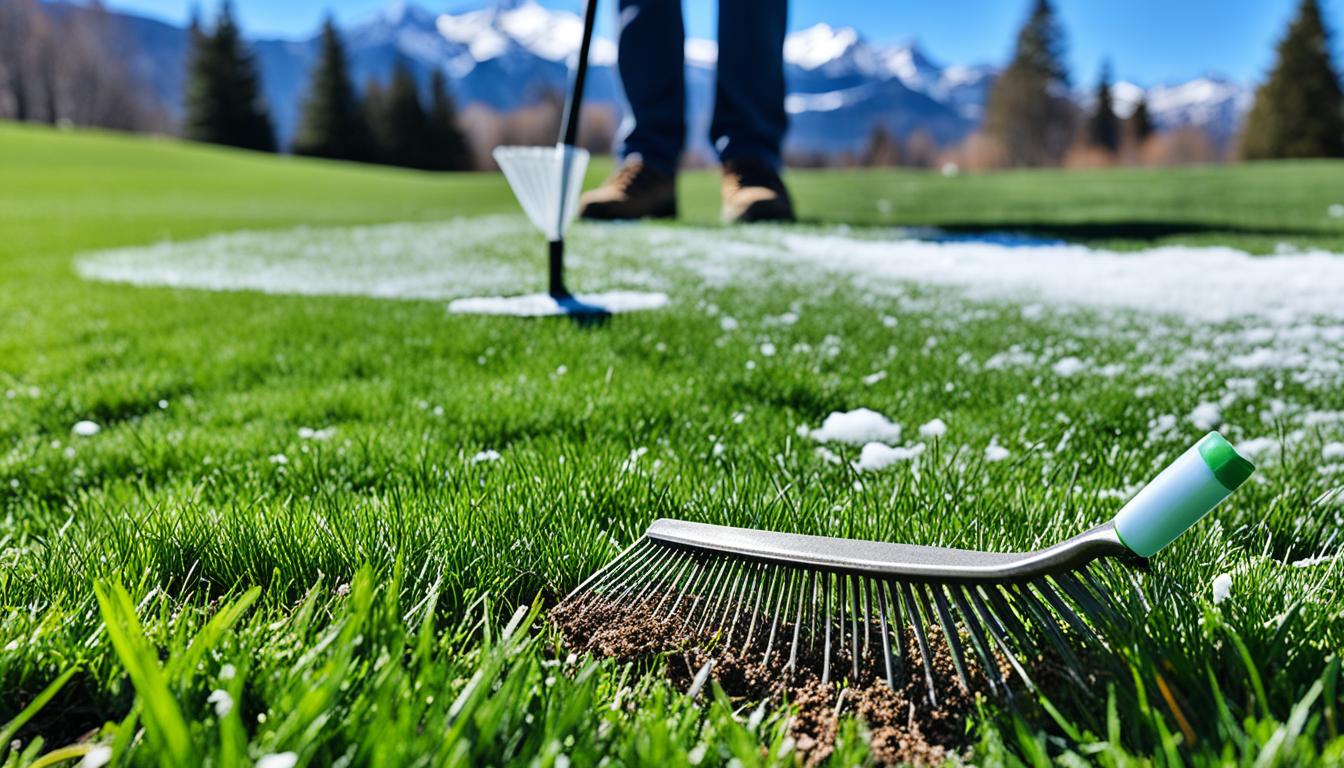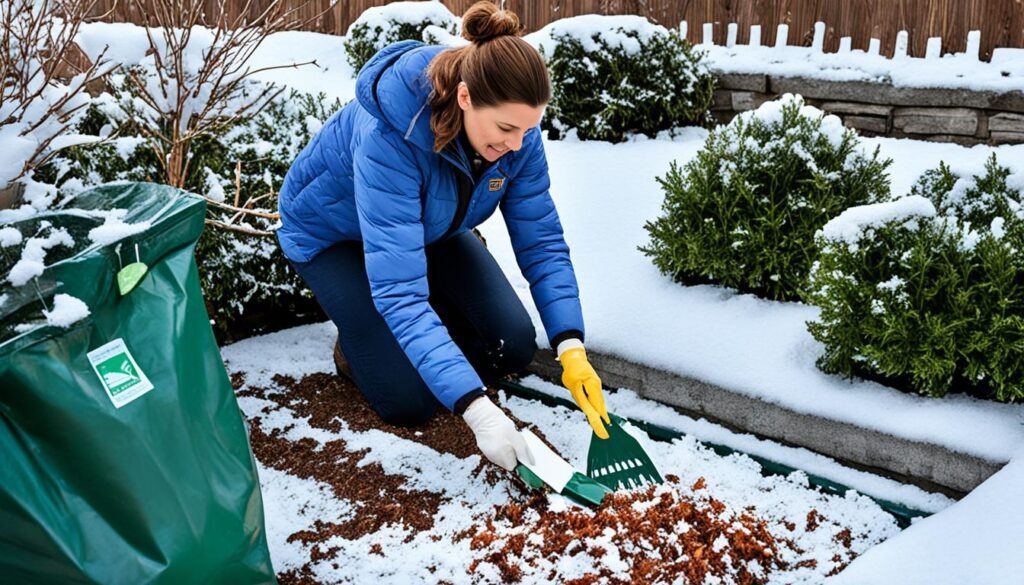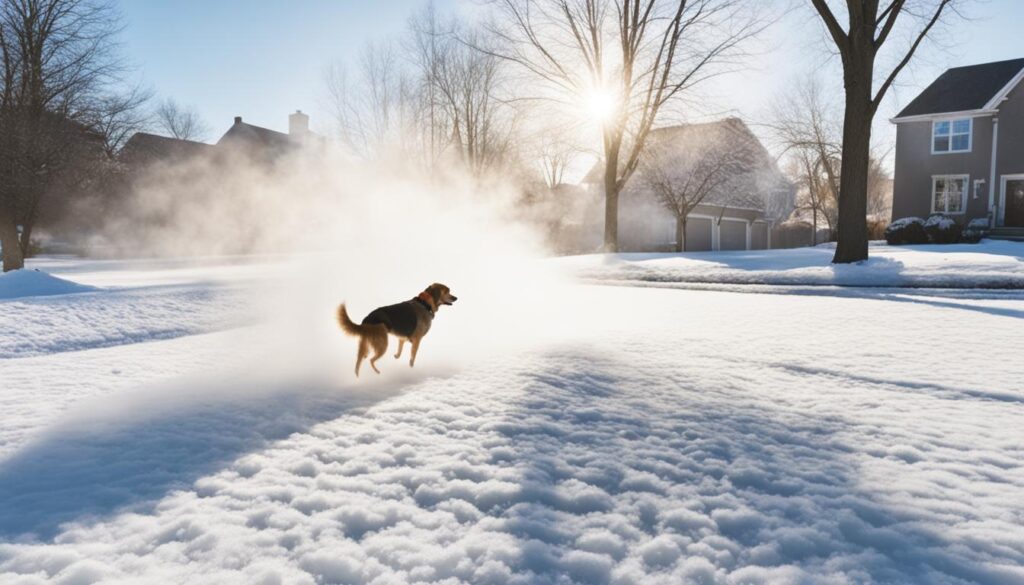
Snow Mold Prevention & Treatment Tips
As winter gives way to spring, it’s important to safeguard your lawn against the risks of snow mold. Snow mold is a common lawn disease that can wreak havoc on your grass as the snow melts, leaving unsightly patches and hampering its overall health. In this section, we will explore effective strategies for preventing and treating snow mold, ensuring the vitality of your landscape.
Key Takeaways:
- Implement preventative measures to safeguard your lawn against snow mold.
- Stay proactive in the maintenance of your lawn, particularly during the fall and winter months.
- Keep your lawns dry and well-aerated to prevent snow mold development.
- Explore proven snow mold treatment options to restore your lawn’s health.
- Regularly clear snow mold and promote recovery in your landscape.
Understanding Snow Mold and Its Causes
Snow mold is a common lawn disease that can cause significant damage to your landscape. Understanding the causes and types of snow mold is essential for effective prevention and treatment. Let’s explore the intricacies of snow mold and how it can impact your lawn.
Snow mold is a fungal infection that affects grass during the winter months. It typically occurs when the ground is covered by snow for an extended period, creating a warm and humid environment that favors the growth of these pathogens.
The Two Types of Snow Mold
There are two primary types of snow mold: gray snow mold (also known as Typhula blight) and pink snow mold (also known as Fusarium patch). Each type has distinct characteristics and can cause varying degrees of damage to your lawn.
Gray snow mold appears as circular patches of gray or straw-colored grass that are matted down. This type of snow mold can survive under the snow, affecting both the grass blades and the underlying roots.
Pink snow mold, on the other hand, appears as circular patches of pink or light tan grass that may have a slimy appearance. This type of snow mold primarily affects the grass blades and can result in the death of the affected areas.
Causes of Snow Mold
The development of snow mold is influenced by several factors, including:
- Prolonged snow cover: The longer the snow persists on the ground, the higher the likelihood of snow mold development.
- Moisture: Excessive moisture during the winter months creates the ideal conditions for snow mold growth.
- Poor lawn maintenance: Neglected lawns that are not properly cared for are more susceptible to snow mold.
- Thatch buildup: Accumulated thatch provides an environment where snow mold can thrive.
Now that we have a better understanding of snow mold and its causes, let’s explore effective strategies to prevent and treat this lawn disease.
Snow Mold Prevention Strategies
To keep your lawn healthy and snow mold-free, it’s essential to implement effective prevention strategies. By following proper lawn maintenance practices, particularly during the fall season, you can minimize the risk of snow mold formation and keep your lawns dry and resilient. Below, we provide a comprehensive list of snow mold prevention tips and techniques.
Fall Lawn Care
Fall is a crucial time for preparing your lawn to withstand the challenges of winter, including snow mold. Here are some key fall lawn care practices to incorporate into your routine:
- Rake fallen leaves and remove any debris from your lawn. Accumulated leaves and debris create a moist environment that promotes snow mold growth.
- Mow your lawn to an optimal height before winter sets in. Cutting the grass too short can weaken it, making it more susceptible to snow mold. Conversely, leaving it too long can lead to excess moisture retention.
- Aerate your lawn to improve soil drainage and allow better airflow. This will help keep your lawns dry and discourage the development of snow mold.
Keeping Lawns Dry
Maintaining dry lawns is crucial for preventing snow mold. Follow these tips to ensure your lawns stay dry:
- Avoid overwatering your lawn, especially in the late fall and winter months. Excess moisture provides an ideal breeding ground for snow mold.
- Monitor and adjust your sprinkler system to prevent over-saturation of your lawn.
- Clear snow from your lawn promptly to prevent prolonged moisture exposure.
- Ensure proper drainage around your property and fix any grading issues that cause water to pool on your lawn.
Additional Snow Mold Prevention Tips
In addition to fall lawn care and keeping your lawns dry, there are other preventative measures you can take to safeguard against snow mold:
- Do not apply excessive amounts of nitrogen fertilizer in the late fall. High nitrogen levels can promote snow mold growth.
- Prune trees and shrubs near your lawn to improve sunlight exposure and airflow, reducing the likelihood of snow mold formation.
- Avoid piling snow on your lawn. Instead, direct the snow to areas that won’t affect your lawns.
- Consider overseeding your lawn with a snow mold-resistant grass variety to boost its resilience.
Remember, prevention is key when it comes to snow mold. By implementing these strategies and staying proactive in your lawn care efforts, you can significantly reduce the risk of snow mold and maintain a lush, healthy lawn throughout the winter months.
Snow Mold Prevention Strategies
| Strategy | Description |
|---|---|
| Fall Lawn Care | Implement lawn care practices in the fall, including leaf removal, optimal mowing height, and aeration. |
| Keeping Lawns Dry | Avoid overwatering, clear snow promptly, and maintain proper drainage to keep lawns dry. |
| Additional Tips | Avoid excessive nitrogen fertilizer, prune trees and shrubs, redirect snow piles, and consider overseeding with resistant grass. |

Snow Mold Treatment and Remedies
When snow mold strikes, swift action is crucial to restore your lawn’s health and prevent further damage. In this section, we will explore effective snow mold treatments and provide practical remedies to clear snow mold and promote recovery in your landscape. By following these tips and techniques, you can revive your lawn and ensure its longevity.
1. Clearing Snow Mold
The first step in treating snow mold is to remove the affected areas. Use a rake or broom to gently lift the matted grass and remove the mold-infested patches. Be careful not to damage the healthy grass beneath. Dispose of the debris properly to prevent further spreading of the mold spores.
2. Lawn Repair
After clearing the snow mold, the next crucial step is to repair the damaged areas. Prepare the soil by loosening it with a garden fork and lightly raking it. Sprinkle grass seed over the bare patches and cover with a thin layer of organic mulch, such as straw. Water the repaired areas regularly to promote germination and growth.
3. Fungicide Application
In severe cases of snow mold or to prevent future outbreaks, applying a fungicide can be beneficial. Select a fungicide specifically formulated for snow mold, following the instructions on the product label. Apply the fungicide evenly over the affected areas, taking care not to overspray. Repeat the application as recommended by the manufacturer.
4. Proper Lawn Care
To prevent snow mold from recurring in the future, it’s essential to practice proper lawn care. Avoid excessive nitrogen fertilization in late fall, as it can promote snow mold growth. Keep your lawn well-maintained and aerated to improve air circulation and water drainage. Regularly remove fallen leaves and debris that can create damp conditions ideal for snow mold development.

By implementing these snow mold treatment tips and remedies, you can effectively tackle snow mold, restore your lawn’s health, and prevent future outbreaks. Remember to stay vigilant and promptly address any signs of snow mold to safeguard the beauty and vitality of your landscape.
Conclusion
Maintaining a healthy lawn and preventing snow mold requires proactive strategies and proper care. By understanding snow mold, implementing preventative measures, and treating any existing mold, you can ensure the vitality of your landscape.
Prevention is key when it comes to snow mold. Regular lawn maintenance, such as proper mowing, raking, and aerating, can go a long way in minimizing the risk of snow mold development. Additionally, keeping your lawns dry and well-drained is essential, especially during the winter months.
If you do find signs of snow mold in your lawn, don’t panic. There are effective treatment options available. Clearing snow mold by gently raking the affected areas and exposing the grass to sunlight can help promote recovery. Applying fungicides or organic remedies can also aid in treating the mold and restoring your lawn’s health.
By taking the necessary precautions and addressing snow mold promptly, you can safeguard your lawn and create a vibrant and beautiful outdoor space. Remember to stay vigilant throughout the year, maintain good lawn care practices, and consult with professionals if needed. With proper care, your lawn can thrive even after the winter snow melts away.




